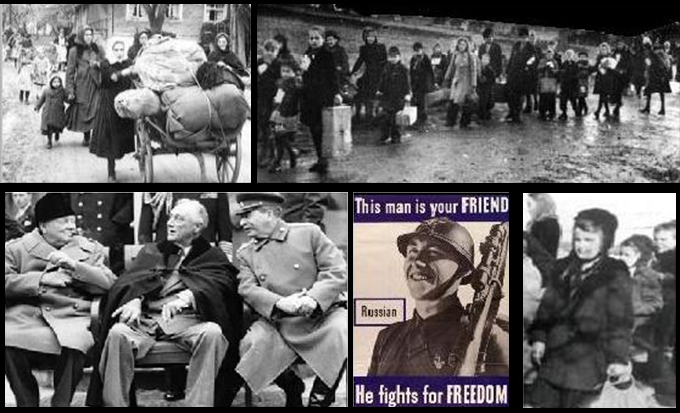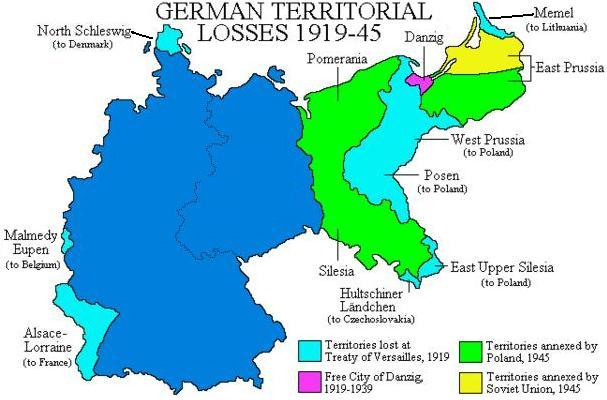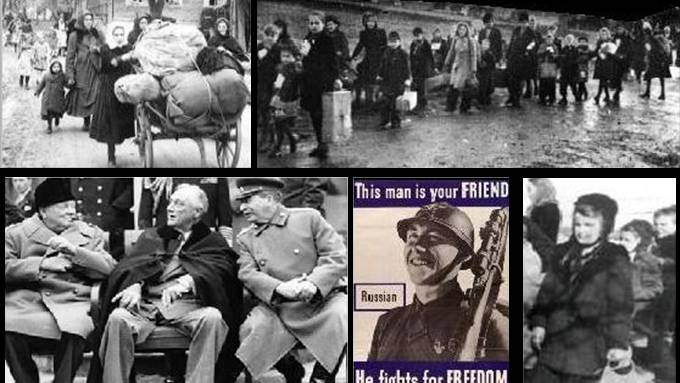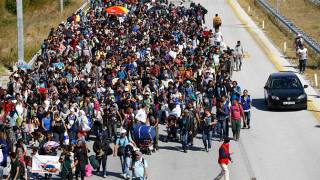The Expulsion and Extermination of Eastern European Germans: An Overview
Source: exulanten.com
"Since the end of the war about 3,000,000 people, mostly women and children and overaged men, have been killed in eastern Germany and south-eastern Europe; about 15,000,000 people have been deported or had to flee from their homesteads and are on the road. About 25 per cent of these people, over 3,000,000 have died. About 4,000,000 men and women have been deported to eastern Europe and Russia as slaves. It seems that the elimination of the German populati the dignity and value of all humanity, on of eastern Europe - at least 15,000,000 people - was planned in accordance with decisions made at Yalta."
Senator Homer Capehart in a speech before U.S. Senate, Feb. 5, 1946. *more

The expulsion of Eastern European Germans resulted in the largest exchange of population in European history. It ended close to 1,000 years of German presence in areas now considered to be parts of Poland, the Czech Republic, Russia and other Eastern European states, forever changing the ethnic face of Europe. Alone, the expulsion of millions of Prussian Germans from their native land between 1944 and 1947 was accomplished in an immensely sinister manner, yet it is an event that has been ignored, minimized or rationalized by the mainstream media.

At the peak of the expulsions in July of 1946, 14,400 people a day were still being dumped over the devastated and famished frontier into an equally devastated and famished Germany which had been reduced to a smaller size than it was in the 11th century.
Most countries which once had a substantial ethnic German presence no longer do. Entire ethnic German cities and regions vanished in the aftermath of the war. When Stalin promised a "modest reduction in the German Population" to Churchill and Roosevelt, his homicidal plans were greeted with a wink and a nod, and that goal was accomplished with lethal zeal.
Agreeing to Stalin's murderous plans to uproot both Poles and Germans, Churchill said in the House of Commons in 1944: "Expulsion is the method which, in so far as we have been able to see, will be the most satisfactory and lasting. There will be no mixture of populations to cause endless trouble. A clean sweep will be made. I am not alarmed by these transferences." In November 1944, Roosevelt agreed, and chief advisors to both Roosevelt and Churchill argued for a solution to the "German problem" as calculated and as chilling as Stalin's. In December, 1945, The New York Times noted that the number of people the Allies proposed to transfer in just a few months equalled the total of all the immigrants admitted to the USA since the beginning of the 20th century!
Aside from countless German civilians who fled in advance of the Red Army and were bombed, drowned or shot at, since the British and Americans agreed at Yalta to redraw historic German borders, they abetted, authorized and encouraged the deportation of millions of ethnic German civilians and gave to vengeance-fueled communist governments the power for who, where and how these citizens would be deported, a power which would inevitably be greatly abused. Among the Allies, who insisted that they nobly fought the war to uphold the dignity and value of all humanity,
were thousands of officials, servicemen and politicians who took active roles in carrying out a program that was contrary to all principles of humanity, a program which, had it been perpetrated by their wartime enemies, would have been considered a criminal violation of human rights.
Chaos, kidnapping, rape, thievery and mass murder were the order of the day in the regions where Germans were expelled. Poles, Czechs and others, with the assistance of the Red Army, sometimes gave the populations of whole German villages only minutes to vacate their homes. The Germans were either collected by force or ordered to gather at a central location where selected individuals were ripped from the group and beaten, executed, or dragged off for slave labor in a ruthless process which even tore children from their mothers' arms.
The evicted Germans were methodically stripped of their most personal and dearest possessions before being taken to train stations where they were indecently prodded for hidden valuables, shoved aboard cars without adequate food, water or sanitation facilities, and speedily shipped to occupation zones in Germany where they were simply dumped. Others were forced to walk hundreds of miles to destinations which were often in rubble, and few of them reached these destinations with even a handbag left in their possession. Many died on the roadside from disease, exposure or starvation. Forbidden to ever return home, all of their worldly goods were confiscated.
Many taken for slave labor were deported to the USSR after Secret Order 7161 of 1944 issued by USSR State Defense Committee made possible the internment of all adult Germans from Romania, Yugoslavia, Czechoslovakia, Hungary and Bulgaria. About ten per cent of the victims died just in the course of transportation to Russia as a result of hunger, murder and cold. Half of the remaining 'repatriated displaced persons' died in camps, one of the worst being the Kolyma Camp. The numbers of deaths and expulsions sky-rocketed at war's end. In the USSR, over 75% of German civilian slaves worked the mines in Ukraine and 11% worked in the Urals. By 1946, out of the German "arrested internees", 39% died, and of 875,000 other German civilians who were abducted and transported to the camps, over 50% perished.
Labor camps for Germans existed not only in the Soviet Union, but in almost all the regions from which Germans were displaced, the last ones not being closed until 1950. In Poland and areas under Polish administration, there were 1,255 camps: 6,048 out of about 8,000 people died in Lamsdorf camp alone. In Czechoslovakia, 2,061 camps existed: in the Mährisch-Ostrau camp around 350 people were tortured to death by early July 1945. In Yugoslavia, the Red Cross found 1,562 gruesome camps and prisons. By May of 1945, practically all of the Yugoslav Germans who did not flee in time were living and dying in camps.
The standard estimates which stood unrevised for sixty years stated that between 1945 and 1950, from 11,730,000 to 15,000,000 German civilians fled and/or were expelled from the eastern territories of Germany proper and from the Eastern European countries and other estimates were much higher. Although, as in the case with mortality figures from Allied bombing, the number of victims is relentlessly downsized, that these violent expulsions displaced and murdered millions of innocents is undeniable. "Population transfers", from highest to lowest, were from former eastern Germany, then Czechoslovakia next, then Poland, Danzig, Yugoslavia, Romania, Hungary, the Baltic states and, lastly, the USSR. And besides the forced expulsion and murder of millions of these people, at least another 3.1 million simply "disappeared" during the expulsion/liquidation process.
Even after a murderous bombing campaign eliminated a large part of their population, five times as many Germans, both civilians and soldiers, perished in the first year after World War Two than died during the course of the entire war, and they died at the hands of others directly as a result of revenge policies inflicted upon a thoroughly dehumanized enemy. 15 to 20 million homeless people, many half insane from shock and grief, wandered amid rotting human bodies dotting the bleak roadsides and paper thin orphans aimlessly navigating through the charred and broken remnants of mercilessly bombed cities.
The Allied Control Council had worked out procedures in advance for taking into the occupied territory 6,650,000 "racial Germans" who were among those they expected to be expelled from Poland, Hungary, Austria and Czechoslovakia under their plans. The US zone's share was to be 1,750,000 from the Sudetenland and 500,000 from Hungary. They were scheduled to come at a rate of a quarter million a month in December, January, and February of 1945 and even larger numbers in the spring. But they came at greater rates, and the Allies were in no way prepared or eager to deal with the situation humanely. In a British camp at Kleve, for instance, thousands of civilians died from hunger, disease and starvation.
Source: exulanten.com
More:
Tom Goodrich - Hellstorm: The Myth of the Good War
Mike King - Hour 1 - The BAD War: Chronology of Events, from 1848 - WWII






















